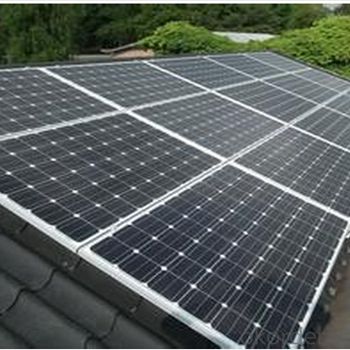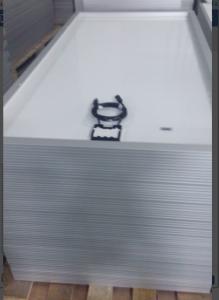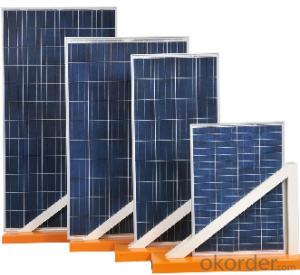Irs Solar Panels - Solar Monocrystalline Series Panels 190-w
- Loading Port:
- Shanghai
- Payment Terms:
- TT OR LC
- Min Order Qty:
- 100 pc
- Supply Capability:
- 30000 pc/month
OKorder Service Pledge
OKorder Financial Service
You Might Also Like
Structure of Monocrystalline Solar Module for 190W Series Description:
Monocrystalline Solar Module for 190W l : High efficiency crystalline solar cell. Even if under the weak light, the solar module can produce maximum power output.
II Tempered glass (toughened glass): Anti-reflecting coating and high transmission rate glass increase the power output and mechanical strength of solar module.
III EVA and TPT: Using high quality EVA and TPT to prevent destroying and water.
IV AI frame: Without screw, rner connection. 6 holes on the frame can be installed easily.
V Junction box: Multi function junction box with water proof.
VI Long lifetime: ≥25 years; Less power decrease.
VII Good performance of preventing from atrocious weather such as wind and hails.
VIII Resisting moisture and etching effectively, not effected by geology.
IX The certificate issued by international authority: UL, TUV, IEC, CE.
Standard Test Conditions of Monocrystalline Silicon Solar Panel:
The opto-electrical specifications shown below are stabilized values being measured at Standard Test Conditions, Irradiance: 1000W/m2, Spectrum: AM1.5 at 25°C, The info below is subject to manufacturing tolerances. Where appropriate minutes of measurement are available and are used for the dimensioning of the installation.
Advantages of Monocrystalline Silicon Solar Panel
• CNBM Solar performance guarantees for 25 years
• 12 years guarantee for workmanship
• Timeliness of delivery
• Quality Products certified (TÜV, UL, CE, ISO)
Monocrystalline Silicon Solar Panel
Our designing philosophy is making solar product easy to use and convenient to maintain. We adhere to "develop inverter and controller" as our core technology, and built up solar product from 0.5W to 100KW into standard and mass production, meeting most customers' needs in this field.
| Parameter Type | Max Power (W) | Dimension(mm) | Weight | Max Current (A) | Max Voltage (V) | Short Circuit | Open Circuit |
| Current(A) | Voltage(V) | ||||||
| ESC 300W/36M | 300 | 1960*986*50 | 23.5 | 8.33 | 36 | 9.33 | 43.2 |
| ESC 295W/36M | 295 | 1960*986*50 | 23.5 | 8.19 | 36 | 9.18 | 43.2 |
| ESC 290W/36M | 290 | 1960*986*50 | 23.5 | 8.06 | 36 | 9.02 | 43.2 |
| ESC 285W/36M | 285 | 1960*986*50 | 23.5 | 7.92 | 36 | 8.87 | 43.2 |
| ESC 280W/36M | 280 | 1960*986*50 | 23.5 | 7.78 | 36 | 8.71 | 43.2 |
| ESC 275W/36M | 275 | 1960*986*50 | 23.5 | 7.64 | 36 | 8.56 | 43.2 |
| ESC 270W/36M | 270 | 1960*986*50 | 23.5 | 7.50 | 36 | 8.40 | 43.2 |
| ESC 265W/36M | 265 | 1960*986*50 | 23.5 | 7.36 | 36 | 8.24 | 43.2 |
| ESC 260W/36M | 260 | 1960*986*50 | 23.5 | 7.22 | 36 | 8.09 | 43.2 |
| ESC 255W/36M | 255 | 1960*986*50 | 23.5 | 7.08 | 36 | 7.93 | 43.2 |
| ESC 250W/36M | 250 | 1960*986*50 | 23.5 | 6.94 | 36 | 7.78 | 43.2 |
| ESC 240W/48M | 240 | 1580*1066*50 | 20.0 | 5.00 | 48 | 5.60 | 56.6 |
| ESC 230W/48M | 230 | 1580*1066*50 | 20.0 | 4.79 | 48 | 5.37 | 56.6 |
| ESC 230W/30M | 230 | 1640*986*50 | 19.0 | 7.67 | 30 | 8.59 | 36.0 |
| ESC 225W/30M | 225 | 1640*986*50 | 19.0 | 7.50 | 30 | 8.40 | 36.0 |
| ESC 220W/48M | 220 | 1580*1066*50 | 20.0 | 4.58 | 48 | 5.13 | 56.6 |
| ESC 220W/30M | 220 | 1640*986*50 | 19.0 | 7.33 | 30 | 8.21 | 36.0 |
| ESC 215W/30M | 215 | 1640*986*50 | 19.0 | 7.17 | 30 | 8.03 | 36.0 |
| ESC 210W/48M | 210 | 1580*1066*50 | 20.0 | 4.38 | 48 | 4.90 | 56.6 |
| ESC 210W/30M | 210 | 1640*986*50 | 19.0 | 7.00 | 30 | 7.84 | 36.0 |
| ESC 210W/27M | 210 | 1480*986*45 | 18.0 | 7.78 | 27 | 8.71 | 32.4 |
| ESC 205W/27M | 205 | 1480*986*45 | 18.0 | 7.59 | 27 | 8.50 | 32.4 |
| ESC 200W/27M | 200 | 1480*986*45 | 18.0 | 7.41 | 27 | 8.30 | 32.4 |
| ESC 200W/48M | 200 | 1580*1066*50 | 19.5 | 4.18 | 47.8 | 4.78 | 54.62 |
| ESC 195W/27M | 195 | 1480*986*45 | 18.0 | 7.22 | 27 | 8.09 | 32.4 |
| ESC 190W/27M | 190 | 1480*986*45 | 18.0 | 7.04 | 27 | 7.88 | 32.4 |
| ESC 185W/27M | 185 | 1480*986*45 | 18.0 | 6.85 | 27 | 7.67 | 32.4 |
| ESC 185W/36M | 185 | 1580*808*45 | 16.0 | 5.14 | 36 | 5.76 | 43.2 |
| ESC 180W/36M | 180 | 1580*808*45 | 16.0 | 5.00 | 36 | 5.60 | 43.2 |
| ESC 175W/36M | 175 | 1580*808*45 | 16.0 | 4.86 | 36 | 5.44 | 43.2 |
| ESC 170W/36M | 170 | 1580*808*45 | 16.0 | 4.72 | 36 | 5.29 | 43.2 |
| ESC 165W/36M | 165 | 1580*808*45 | 16.0 | 4.58 | 36 | 5.13 | 43.2 |
| ESC 160W/36M | 160 | 1580*808*45 | 16.0 | 4.44 | 36 | 4.98 | 43.2 |
| ESC 135W/27M | 135 | 1196*808*35 | 13.0 | 5.00 | 27 | 5.60 | 32.4 |
| ESC 130W/27M | 130 | 1196*808*35 | 13.0 | 4.81 | 27 | 5.39 | 32.4 |
| ESC 125W/27M | 125 | 1196*808*35 | 13.0 | 4.63 | 27 | 5.19 | 32.4 |
| ESC 120W/27M | 120 | 1196*808*35 | 13.0 | 4.44 | 27 | 4.98 | 32.4 |
| ESC 115W/27M | 115 | 1196*808*35 | 13.0 | 4.26 | 27 | 4.77 | 32.4 |
| ESC 110W/27M | 110 | 1200*808*35 | 12.7 | 4.08 | 27 | 4.74 | 31.39 |
| ESC 100W/18M | 100 | 1196*540*35 | 10 | 5.68 | 17.57 | 6.6 | 21.6 |
| ESC 95W/18M | 95 | 1196*540*35 | 10.0 | 5.28 | 18 | 5.91 | 21.6 |
| ESC 90W/18M | 90 | 1196*540*35 | 10.0 | 5.00 | 18 | 5.60 | 21.6 |
| ESC 85W/18M | 85 | 1196*540*35 | 10.0 | 4.72 | 18 | 5.29 | 21.6 |
| ESC 80W/18M | 80 | 1196*540*35 | 10.0 | 4.44 | 18 | 4.98 | 21.6 |
| ESC 75W/18M | 75 | 1196*540*35 | 10.0 | 4.17 | 18 | 4.67 | 21.6 |
| ESC 60W/18M | 60 | 810*540*30 | 7.0 | 3.33 | 18 | 3.73 | 21.6 |
| ESC 55W/18M | 55 | 810*540*30 | 7.0 | 3.06 | 18 | 3.42 | 21.6 |
| ESC 50W/18M | 50 | 810*540*30 | 7.0 | 2.78 | 18 | 3.11 | 21.6 |
| ESC 45W/18M | 45 | 620*540*35 | 5.0 | 2.50 | 18 | 2.80 | 21.6 |
| ESC 40W/18M | 40 | 610*540*30 | 5.0 | 2.22 | 18 | 2.49 | 21.6 |
| ESC 30W/18M | 30 | 440*540*30 | 3.5 | 1.67 | 18 | 1.87 | 21.6 |
| ESC 25W/18M | 25 | 440*540*30 | 3.5 | 1.39 | 18 | 1.56 | 21.6 |
| ESC 20W/18M | 20 | 430*430*30 | 3.0 | 1.11 | 18 | 1.24 | 21.6 |
| ESC 15W/18M | 15 | 285*450*30 | 2.0 | 0.83 | 18 | 0.93 | 21.6 |
| ESC 10W/18M | 10 | 285*341*30 | 1.5 | 0.56 | 18 | 0.62 | 21.6 |
FAQ
We have organized several common questions for our clients,may help you sincerely:
①What price for each watt?
It depends on the quantity, delivery date and payment terms,
②What is your size for each module? Can you tell me the Parameter of your module?
We have different series of panels in different output, both c-Si and a-Si. Please take the specification sheet for your reference.
③Can you provide the peripheral products of the solar panels, such as the battery, controller, and inverter? If so, can you tell me how do they match each other?
Yes, we can, we have two companies for solar region, one is CNBM International, the other is CNBM engineering Co.
We can provide you not only the solar module but also the off grid solar system, we can also provide you service with on grid plant.
④What is your warranty system?
Our product performance guarantees for 25 years
• 12 years guarantee for workmanship
• Timeliness of delivery
• Quality Products certified (TÜV, UL, CE, ISO)
⑤How do you pack your products?
We have rich experience on how to pack the panels to make sure the safety on shipment when it arrives at the destination.
⑥ Can you do OEM for us?
Yes, we can.
⑦How long can we receive the product after purchase?
In the purchase of product within three working days, We will arrange the factory delivery as soon as possible. The pecific time of receiving is related to the state and position of customers.Commonly 7 to 10 working days can be served.
- Q: I'm thinking of having solar panels to generate electricity. The drawbacks are that I'm afraid if it needs repair, I won't be able to find anyone. Also I'm afraid that the roof is not very accessible. If it is a new house, should the roof have a roof hatch? What can make the system not work?
- Modern solar electric panels rarely fail. Because of this, if you would be installing them over a roof that only has a few years left on it, it would be better to redo the roof, first. In the unlikely event that a panel needs to be changed, this can be done in 30 minutes or so, because the panels are mounted on racks, with everything simply plugging together. I have never personally seen a solar installation go bad, but from what I hear, the inverter (a box that goes in next to your electric service panel) is usually what burns out after 5 years, assuming the install was done right in the first place. If you were to call roofers to repair your roof, they would somehow be able to get to your roof, by ladders, or a special truck. Solar installers use the same kind of equipment. They won't have a problem getting up there. A solar electric system is actually a very straightforward thing. No matter who installs it, if there is a problem, another installer should be able to diagnose and fix it.
- Q: Can solar panels be used for powering remote monitoring systems?
- Yes, solar panels can be used to power remote monitoring systems. Solar panels capture sunlight and convert it into electricity, which can then be used to power various devices and systems, including remote monitoring systems. This makes solar panels an environmentally friendly and cost-effective solution for powering such systems in remote locations where access to the electrical grid may be limited or non-existent.
- Q: Can solar panels be used for powering water treatment plants?
- Yes, solar panels can be used for powering water treatment plants. Solar energy can be harnessed to generate electricity, which can then be used to power the various processes and equipment involved in water treatment plants. This environmentally-friendly approach helps reduce reliance on fossil fuels and contributes to sustainable water management practices.
- Q: Do solar panels produce noise?
- No, solar panels do not produce noise as they do not have any moving parts.
- Q: Can solar panels be installed on hospitals or healthcare facilities?
- Yes, solar panels can definitely be installed on hospitals or healthcare facilities. In fact, many hospitals and healthcare facilities around the world have already embraced solar energy as a sustainable and cost-effective solution. Solar panels provide a reliable source of clean energy, helping these facilities reduce their carbon footprint and dependence on traditional energy sources. Additionally, solar power can contribute to long-term cost savings, allowing hospitals to allocate more resources towards patient care and medical services.
- Q: Mono-crystalline or poly-crystalline solar panel?
- All solar photovoltaics drop in efficiencies with higher temperatures but it isn't the 45+ C you have to worry about but rather the heat from the sunlight striking the panels. There are hybrid systems which passes water in pipes attached to the back of the solar panels to cool the panels and preheat the water for solar thermal collectors. The difference between mono-crystalline and poly-crystalline are that mono-crystalline are more efficient and more costly to make.
- Q: Can solar panels be installed on desalination plants?
- Yes, solar panels can be installed on desalination plants. Solar energy can be harnessed to power the desalination process, reducing the reliance on traditional energy sources and making the plants more sustainable and environmentally friendly.
- Q: I have thermal solar panels on my roof. Iive in Colorado
- The problem with solar thermal is that it's a lot of plumbing. You should have a professional remove it. If you can't find a suitable solar company, try plumbers at least to disconnect the panels. Of course solar thermal systems are fairly simple devices, you should be able to just repair them.
- Q: I have had this 2v portable Solar Panel for my apartment for awhile. Only problem is that I have no balcony and I can barely get enough sun to use it with my Cobra 450 400-800 watt outlet converter. Can someone advise me a better method to use these? Like do I have to get more 2v solar panels? I have a small apartment and use it on one window. Also is it possible for me to buy a portable storage tank to store the energy gathered from the sun by the solar panel?
- portable storage tank would be lead acid batteries. Use only marine sealed type for safety, about $300 each. You will need a charge controller to control the charging of the batteries. If you don't get enough sunlight, then the only alternative (aside from using the roof) is to get more panels. .
- Q: The colder a solar panel gets the more efficient it seems to be. As the panel warms, it loses some efficiency. Why is this so? Please explain in a way you would expect a high school kid to understand it, as I am a high-schooler and i have to explain this to other high-schoolers.
- For water heater type of solar panel the hot panel has more radiation losses reducing the heat available to be transferred to the water. In PV panels it has got to be characteristics of the PV cells. If the conversion efficiency drops with temperature rise then only this can happen. PV=photo-voltaic
Send your message to us
Irs Solar Panels - Solar Monocrystalline Series Panels 190-w
- Loading Port:
- Shanghai
- Payment Terms:
- TT OR LC
- Min Order Qty:
- 100 pc
- Supply Capability:
- 30000 pc/month
OKorder Service Pledge
OKorder Financial Service
Similar products
Hot products
Hot Searches
Related keywords



























